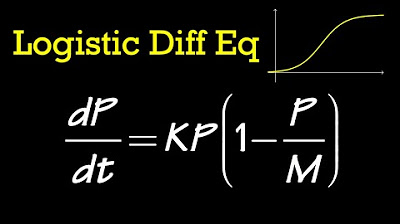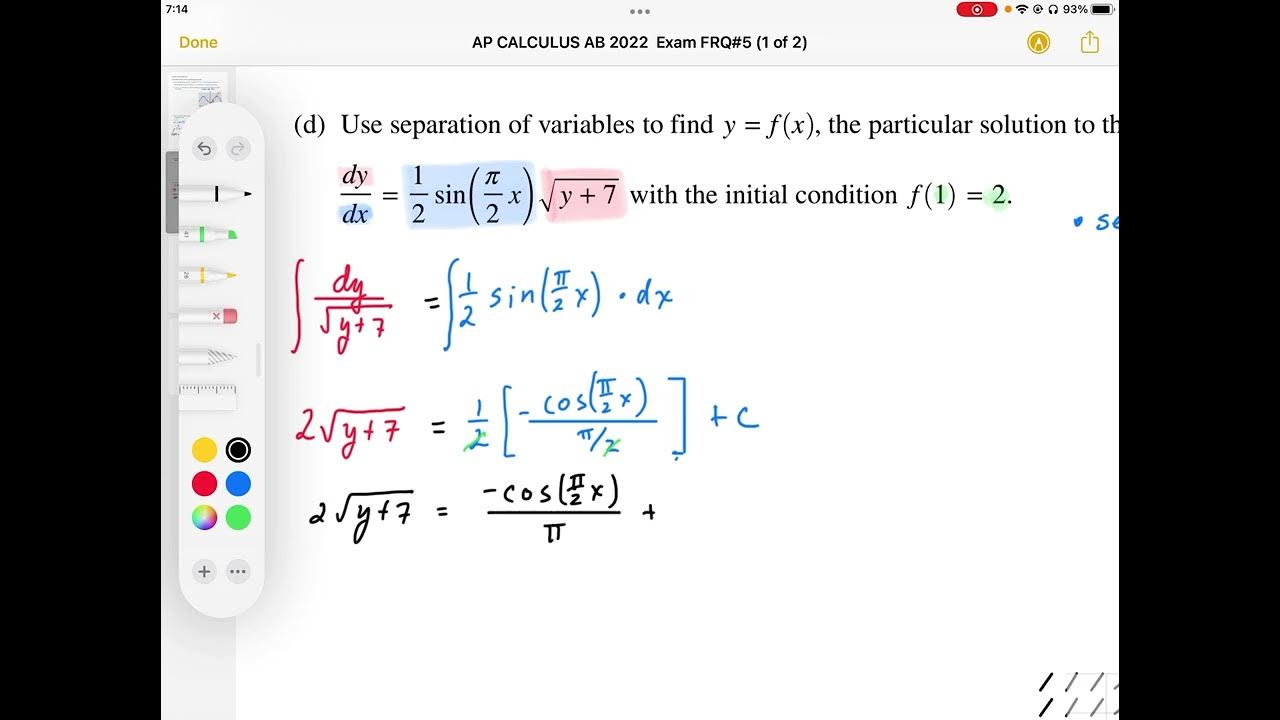2011 Calculus AB free response #5c. | AP Calculus AB | Khan Academy
TLDRThe video script presents a step-by-step guide to solving a first-order linear differential equation, dw/dt = (1/25)(W - 300), with the initial condition W(0) = 1400. The solution process involves separating variables, integrating, and applying the initial condition to find the constant of integration. The method used is basic integration, and the final solution is expressed as W(t) = 1100e^(t/25) + 300. The explanation emphasizes the accessibility of solving such problems using only fundamental concepts learned in an AP class.
Takeaways
- 📚 The problem involves solving a differential equation with a given initial condition.
- 🧐 The differential equation is separable, allowing for a solution using basic integration techniques.
- 🔄 The equation is dw/dt = (1/25) * (W - 300), with W(0) = 1400 tons as the initial condition.
- 🤔 The strategy involves separating the variables and integrating both sides of the equation.
- 📈 The process starts by dividing the original equation by (W - 300) and multiplying both sides by dt.
- 🌟 The integral of 1/(W - 300)dW is the natural log of the absolute value of (W - 300).
- 🌟 The integral of 1/25 dt with respect to t is t/25.
- 🔧 The substitution u = W - 300 simplifies the left side of the equation to du = dw.
- 🗝️ The constant of integration C is found by using the initial condition W(0) = 1400, which gives C = ln(1100).
- 📊 The solution is expressed as W = 1100 * e^(t/25) + 300, after solving for C and rearranging the terms.
- 🎓 The solution demonstrates the ability to solve differential equations using skills learned in an AP class, without advanced tools.
Q & A
What type of differential equation is being discussed in the script?
-The script discusses a first-order, linear, separable differential equation.
What is the given differential equation in the script?
-The given differential equation is dw/dt = (1/25) * (W - 300), where W is a function of t and represents the weight in tons.
What is the initial condition provided for the problem?
-The initial condition is that at time t=0, W equals 1400 tons.
How does the script suggest solving the differential equation?
-The script suggests solving the differential equation by separating the variables and integrating, which is a method applicable to problems that can be solved using AP class skills.
What is the significance of the 'W - 300' term in the differential equation?
-The 'W - 300' term represents a transformed variable (u) that allows for the separation of variables, simplifying the process of integrating the differential equation.
How is the constant of integration (C) determined in this problem?
-The constant of integration is determined by using the initial condition that when t=0, W=1400. This gives C as the natural log of 1100.
What is the final solution for W as a function of t?
-The final solution is W = 1100 * e^(t/25) + 300, where e represents the base of the natural logarithm.
Why is the absolute value sign dropped when solving for W?
-The absolute value sign is dropped because it is known that W is an increasing function starting from 1400, and thus the expression (W - 300) will always be positive for positive t values.
What is the role of the exponential function (e) in the solution?
-The exponential function (e) is used to revert the natural logarithm operation performed during integration, effectively solving for W as a function of t.
How does the script emphasize the approach to solving differential equations on an AP exam?
-The script emphasizes that even on an AP exam, the approach to solving differential equations should rely on skills learned in AP classes, particularly focusing on separable equations that can be solved through basic integration techniques.
What is the significance of the differential 'dw' in the context of the problem?
-The differential 'dw' represents an infinitesimally small change in the weight W with respect to the independent variable t. It is a fundamental concept in the calculus of differential equations.
Outlines
📚 Introduction to Solving a Differential Equation
The paragraph begins with an introduction to solving a particular solution of a differential equation, emphasizing that even though it might seem out of place on an AP exam, it can be tackled with the skills learned in an AP class. The main focus is on separable differential equations, where the independent and dependent variables can be separated. The speaker demonstrates how to rewrite the given differential equation, dw/dt = 1/25 * (W - 300), and separate the variables, ultimately leading to the integration process. The explanation includes dividing both sides by (W - 300), multiplying by dt, and then integrating both sides to find the relationship between W and t.
🔍 Solving for the Constant and Expressing W as a Function of t
This paragraph delves into solving for the constant of integration and expressing W as an explicit function of time, t. The speaker uses the initial condition, W(0) = 1400 tons, to find the constant by setting the natural log of the absolute value of (W - 300) equal to the natural log of 1100. The explanation continues with the process of solving for W by raising e to both sides of the equation, simplifying, and ultimately arriving at the solution W = 1100 * e^(t/25) + 300. The paragraph highlights the use of basic integration and the ability to solve the differential equation without advanced tools.
Mindmap
Keywords
💡differential equations
💡separable differential equations
💡initial condition
💡integration
💡antiderivative
💡constant of integration
💡natural log
💡exponential function
💡u-substitution
💡derivative
Highlights
The given problem involves solving a differential equation with an initial condition, where W is in tons and t is in time units.
The differential equation is dw/dt = 1/25 * (W - 300), with W(0) = 1400 tons.
The problem emphasizes that even without a background in differential equations, AP exam-takers can solve such problems using skills from AP classes.
The main class of differential equations solvable with AP skills are separable differential equations, where independent and dependent variables can be separated.
The first step in solving the equation is to separate the variables, putting all W-related terms on one side and dt-related terms on the other.
By dividing both sides of the equation by (W - 300), the equation becomes 1/(W - 300) * dw/dt = 1/25.
To get dt terms on one side, the equation is multiplied by dt, which represents a very small change in time.
The process of solving the differential equation involves integrating both sides, which sums up the increments of W and dt.
A u-substitution is introduced with u = W - 300, allowing for the simplification of the left-hand side of the equation to du = dw.
The integral of the left-hand side becomes the natural log of the absolute value of u, or equivalently, the natural log of the absolute value of (W - 300).
The antiderivative of the right-hand side with respect to t is t/25, which simplifies to W as a function of t.
The initial condition W(0) = 1400 is used to solve for the constant C, which is found to be the natural log of 1100.
The absolute value sign can be dropped since W is an increasing function and will always be positive for positive t values.
The final solution is expressed as W = 1100 * e^(t/25) + 300, after solving for C and explicitly writing W as a function of t.
The solution to the differential equation is obtained through basic integration techniques, without the need for advanced differential equation solving tools.
The problem demonstrates the application of AP class skills in solving real-world mathematical problems, such as those involving differential equations.
Transcripts
Browse More Related Video
5.0 / 5 (0 votes)
Thanks for rating:





